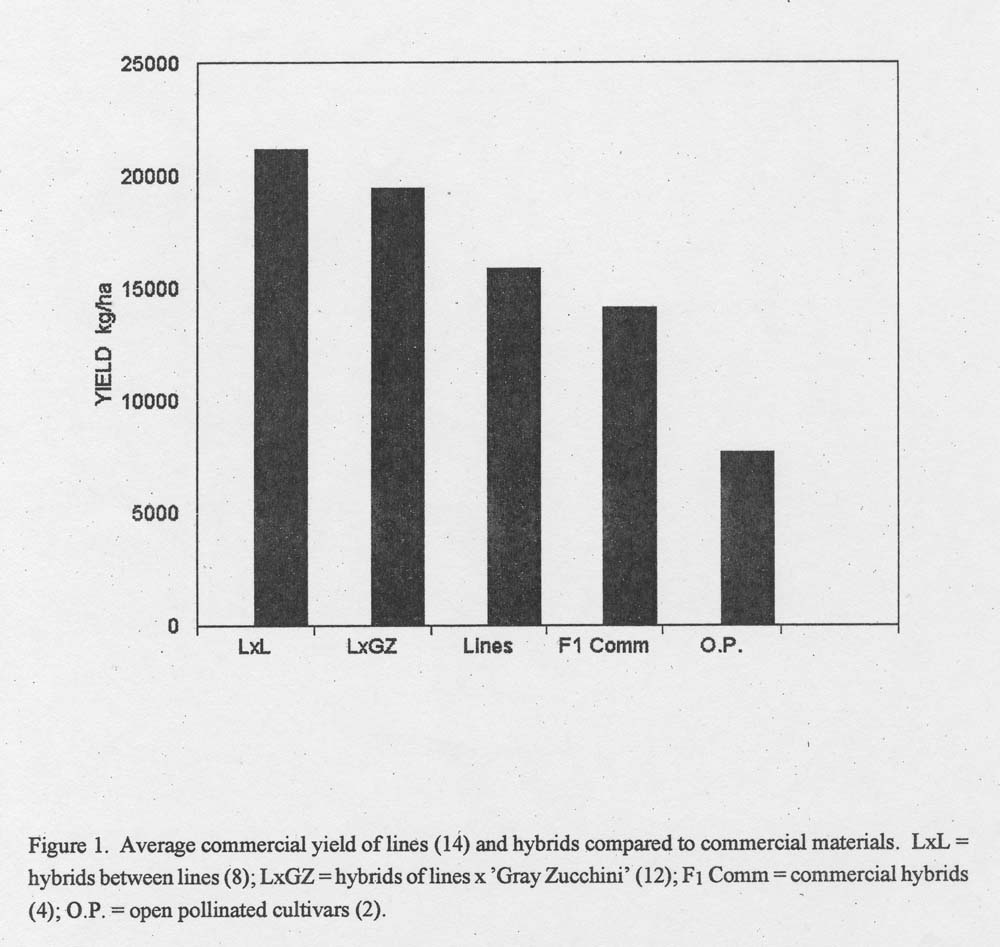Cucurbit Genetics Cooperative Report 19:78-80 (article 28) 1996
Andres Tacho Amaya and Sergio Garza Ortega
Departmento de Agricultura y Ganaderia. Universidad de Sonora. Ap. Postal 305. Hermasillo, Sonora, Mexico
Cucurbita moschata landraces commonly found in Mexico exhibit a high degree of variability (4). In our collection we have observed useful traits such as attractive butternut fruit shape and field resistance to a virus disease which clearly infects other species, particularly C. pepo and C. maxima (1,5). Interspecific crosses between C. pepo and C. mochata were performed in 1983 seeking improvement of the cultivar Gray Zucchini (GZ) which is preferred in Mexico over other cultivars of summer squash. Crosses using GZ were unsuccessful but by using CV. Classic as a female parent, viable F1 seeds were obtained. An F2 generation consisting of 380 plants was obtained in 1986 (2). Eight of these plants free of any viral symptom we reused to start a backcross program to GZ and after 4 backcrosses and 3-5 selfing generations, GZ-type lines were developed. Other lines were developed starting in 1987 by the cultivation of small weak embryos obtained from crosses between the two species and then by backcrossing and selfing. This paper reports on the behavior of such lines and hybrid combinations in comparison to commercial materials.
Materials and Methods. In the summer-fall of 1993 14 lines, 8 F1 hybrids between lines, 12 line x GZ hybrids, the open pollinated cultivars GZ and Black Zucchini (BZ), and the F1 commercial hybrids ‘Corsair’, ‘Raven’, ‘Classic’, and ‘Onyx’ were established by direct seeding followed by conventional cultural practices for summer squash production. Treatments were arranged in a randomized complete block design with 4 replications. Plots measured 4.3 m with 3 plants per meter. Yield, degree of virus infection on foliage, and plant size and morphology were determined.
Results and Discussion. The highest single yield (32,674 kg/ha) was obtained for the F1 hybrid of the cross 2-6-4 x 7-1-1, whereas the lowest (4,872kg/ha) was for BZ. The standard GZ produced 10,384 kg/ha (HSD value was 12,674 kg/ha). Six of the line x GZ hybrids and two line x line hybrids showed positive heterosis. Figure 1 shows the average commercial yield obtained for all hybrids between lines (21,174 kg/ha), line x GZ hybrids (19,948 kg/ha), lines (15,800 kg/ha), commercial hybrids (14,114 kg/ha), and open pollinated cultivars (7,628 kg/ha).
Symptoms of viral infection were very high for commercial materials as shown in table 1. On the other hand, lines and hybrids had healthier plants. Although virus identification for this test was not possible, symptoms on foliage indicated that SLCV was present. Four of the lines were inoculated in 1995 with CMV, ZYMV, WMV, and PRSV and were susceptible to all. One line had delayed symptoms for CMV indicating that it may possess some field resistance (3). In similar materials established in the spring of 1995, ZYMV and SMV were found. During the fall of 1995 a SLCV test was performed in one of the lines and was positive despite plants showing no symptoms of he disease.
Stem length varied from 34.2 cm to 64.1 cm and number of stems from 1 to 4 (data not shown).
These results show that as reported for interspecific crosses in Cucurbita (6), local C. moschata landraces may be used to improve C. pepo cultivars. Once an improved line has been obtained, it may be used as a parent to produce better offspring.
Table 1. Degree of symptoms of virus infection on foliage. Data show average of 8 line x line hybrids, 12 line x ‘Gray Zucchini’ hybrids, 14 lines, 2 open pollinated cultivars, and 4 commercial hybrids.
Materials tested |
Virus infection indexz |
| Line x Line | 0.02 |
| Line x Gray Zucchini | 0.27 |
| Lines | 0.30 |
| O.P. cultivars | 3.50 |
| Commercial hybrids | 3.97 |
zInfection index was rated on a 0 to 4 scale: 0 = no infection, 2 = slight, 3 = strong, 4 = severe.
Figure 1. Average commercial yield of lines (14) and hybrids compared to commercial materials. LxL = hybrids between lines (8); LxGZ = hybrids of lines x ‘Gray Zucchini’ (12); F1 Comm = commercial hybrids (4); O.P. = Open pollinated cultivars (2).

Literature Cited
- Fierro Quintero, A. 1987. Evaluacion de 22 lineas de calabaza Cehualca Cucurbita moschata (Duch) Duch. ex Poir. B.S. Thesis, Univ. de Sonora, Mexico.
- Garza Ortega, S. and J.D. Castro Encinas. 1987. Observaciones sobre segregacion de algunas caracteristicas de una generacion F2 de una cruza interspecifica en Cucurbita. Soc. Mexicana de Ciencias Horticolas. II Congreso Nacional. Irapuato, Maxico (Abstract).
- Kyule, M.M. 1995. Personal communication.
- Merrick, L.C. 1991. Systematics, evolution, and ethnobotany of a domesticated squash, Cucurbita argyrisoerma. PhD Dissertation, Cornell University, USA.
- Rodriguez Duarte, M.R. 1988. Evaluacion de 23 linease de calabaza Cehualca Cucurbita moschata (Duch) Duch. ex Poir. B.S. Thesis, Univ. de Sonora, Mexico.
- Whitaker, T.W. and R.W. Robinson. 1986. Squash breeding. In: Bassett, J.M., ed. Breeding vegetable crops. AVI Publ. Co., Westport, Conn. 584 p.